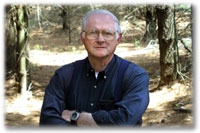Steve with struggling pumpkins. Jerry Apps Photo.
The vegetable garden year at Roshara has ended. And what a year it has been. Everything was planted on time: potatoes, onions, lettuce, spinach, kale, radishes, carrots and beets on April 25. Sweet corn, pumpkins, winter squash, zucchini, cucumbers, cabbage plants, kohlrabi, gourds and tomatoes on May 23.
Although we had periods of dry weather and periods of too much rain, everything came up and was growing well. Steve put up the fence to keep out the deer, wild turkeys and raccoons. One of our best-looking gardens. And then it happened. The rabbits invaded. Many of them. All hungry. They ate everything but the tomatoes, potatoes and vine crops. Ate the beans, lettuce, kale, beets, and cabbage right down to the ground. Hungry little buggers. In my more than 50 years of vegetable gardening, I had never seen anything like it. Nothing close.
So, my end of year garden report is a bit thin. Here are the grades: Potatoes--A—good yield. No scab. Blight held off until the potatoes were ready for harvest. Tomatoes--B—Quite good. Some blight. Sweet corn—C. Winter Squash—D, really never got going. Pumpkins—C. Harvested several little decorative pumpkins. Halloween size pumpkins struggled. Cucumbers—A. Did well; harvested a bunch. Carrots—C. Rabbits don’t like carrots. Don’t laugh, but by far the most successful crop was the zucchini. It grew and grew, and produced more than anything else in the garden. A+ for the zucchini. Of course, the old saying holds, if you can’t grow anything else, you can probably grow zucchini.
Anyone have a suggestion for keeping those hungry little cotton tails out of my garden next year?
THE OLD TIMER SAYS: Just when you think you’ve got everything figured out—you don’t. Gardening is like that.
UPCOMING EVENTS
October 2, Dregne’s, Westby. Book signing. 10:30 -2:30.
WHERE TO BUY MY BOOKS:
My newest novel is Settlers Valley. You can buy it at your local bookstore, order online from bookshop.org, or purchase from the Friends of the Patterson Memorial Library in Wild Rose—a fundraiser for them. Phone: 920-622-3835 for prices and ordering.
Patterson Memorial Library
500 Division Street
Wild Rose, WI 54984
barnard@wildroselibrary.
www.wildroselibrary.org
If you live in the western part of the state, stop at Ruth’s home town, Westby and visit Dregne’s. and look at their great selection of my books, including my new ones, or order a book by calling them at 1-877-634-4414. They will be happy to help you.




